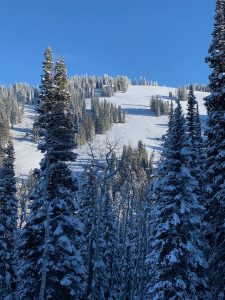It’s late fall and many mountains throughout the U.S. have seen some decent early season snow. As a result, stoke is high and people are itching to ski. Not many ski areas are open yet, however, and the ones that are only have a few groomers to chose from. This invariably pushes people into the backcountry and the higher peaks where more snow has accumulated in the early days of the season. To further increase the backcountry temptation, many remote roads remain open, providing an even greater ease of access to November turns. But just because it’s early season, it doesn’t mean avalanches can’t happen. As the saying goes, “If there’s enough snow to ride, there’s enough snow to slide.” Here are a few thoughts on how to assess snowpack and steer clear of early season slides.

Steve Banks and friends mining for early season turns on Mt. Baldy, Colo. [Photo] Steve Banks
What Lies Beneath
It may be obvious, but just below that thin snowpack lurks rocks, stumps and trees. It may look deep and fluffy, but that doesn’t mean there aren’t hazards just under the surface. I’ve seen plenty of knees split open and busted hands from early season conditions. Take it easy—there’s a long season ahead, and November is not the month you find the deepest pow.
A shallow snowpack doesn’t necessarily mean a stable snowpack. In fact, quite the opposite can be true. We know that a shallow snowpack (less than three to four feet of snow) is more prone to having faceting problems, creating weak snow especially near the ground. The longer days, higher sun and warmer fall temperatures—even if it doesn’t feel that way right now—can also build crusts in between early season storms. In some areas, especially at lower elevations, it isn’t uncommon to see a fluctuating freeze line where rain falls on snow or vice versa. These mixed conditions can create several layers within a shallow snowpack. The more differences there are in the snow the more likely we are to see avalanches.
Different Seasons, Different Terrain
The biggest factor—and often overlooked in avalanche assessment—is terrain. We know we can avoid avalanches much more effectively by avoiding certain types of terrain, and in the early season, the most alluring lines, i.e. areas with the most snow, are also the most likely to produce an avalanche. Typically we seeking out gullies at higher elevations near ridge tops where the snow has drifted in deeper and gives us something to ride. But these are also the areas that host buried weak layers, wind slabs and a higher degree of variability. This time of year, it can be tricky to find the slopes with enough snow to ride, while also presenting minimal avalanche risk. Wind-loaded slopes are much more likely to produce avalanches, but in the early season they are often the only slopes with enough snow to get on. In riding them, we invite more risk into our lives.
Moderate your stoke
Then, of course, there’s the human factor. Our stoke level this time of year is high. All the new ski films are out and we’re anxious to get in our first turns. Maybe we can’t quite find all our safety gear. Maybe we forgot to take the batteries out of our beacons and had a little leakage issue. Maybe our airbag cartridge is empty from blowing it off after that final day last spring.

Early season turns in mellow terrain can be tough to find, but if you hike high enough in the Teton Range, you have a few options. [Photo] Tom Hallberg
Take the time to be prepared. Get your kit dialed in. Spend a little more time making your plan with your riding buddies. Be patient with other backcountry users and communicate with them so everyone knows each other’s plans.
Bottom Line: Early season is a great time to get out and have some fun, enjoy the mountains and share some turns with your buds, but don’t overlook the hazards. It would be a shame to ruin your season on a few mediocre turns and a bad decision.
—










Vermont transplant? Of course. Now you see?